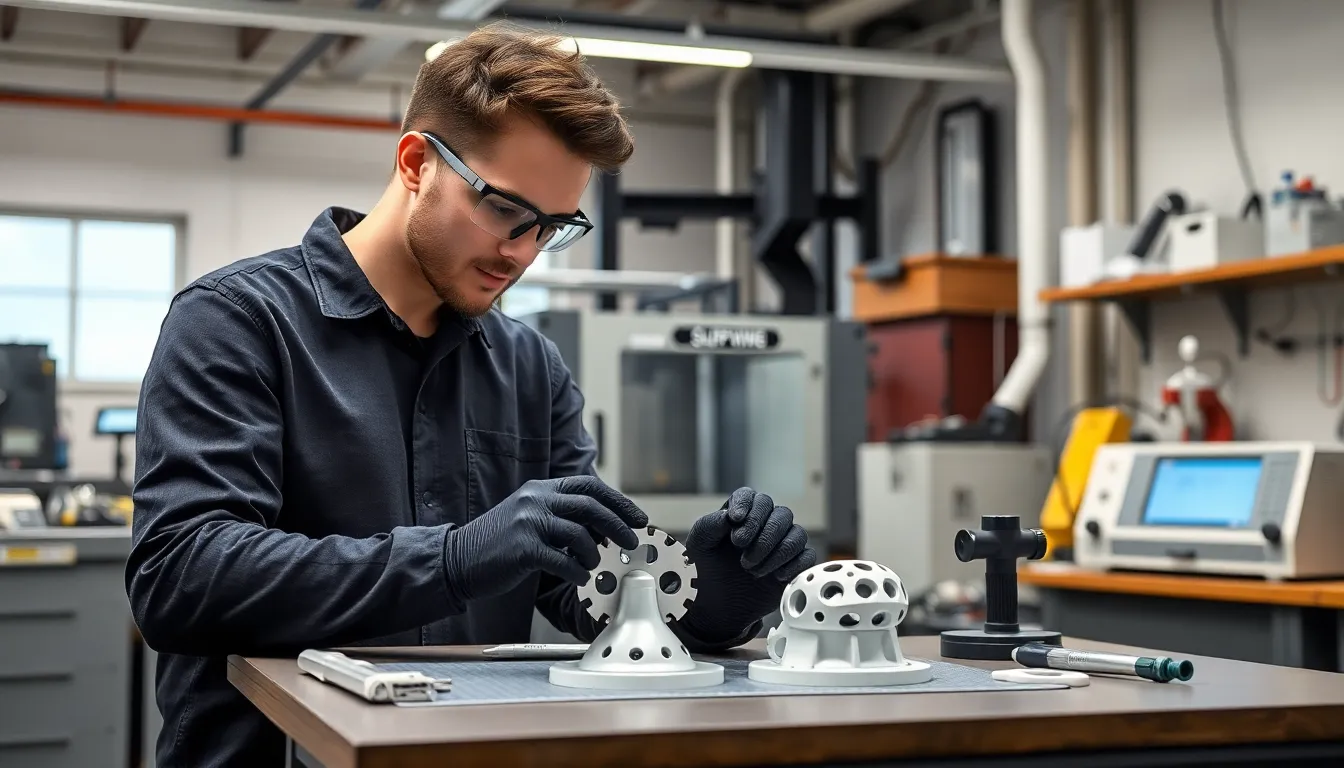Aluminum 3D printing is like the superhero of the manufacturing world, swooping in to save the day with lightweight, durable solutions. Forget the days of bulky metal components weighing you down—this innovative technology is here to revolutionize how things are made. Whether it’s aerospace, automotive, or even your next DIY project, aluminum 3D printing offers a blend of strength and versatility that traditional methods just can’t match.
Imagine crafting intricate designs that are both functional and feather-light. With aluminum’s unique properties, this process not only speeds up production but also opens the door to creativity that would make even the most seasoned engineers giddy. So buckle up as we dive into the fascinating world of aluminum 3D printing, where imagination meets cutting-edge technology and the possibilities are as endless as your next great idea.
Table of Contents
ToggleOverview of Aluminum 3D Printing
Aluminum 3D printing represents a significant advance in manufacturing methods. This technique utilizes metal additive manufacturing, enabling the production of complex geometries that traditional processes might struggle to achieve. Applications in aerospace demonstrate remarkable weight reduction, essential for enhancing fuel efficiency without sacrificing strength.
In automotive production, aluminum 3D printing contributes to manufacturing lightweight components, resulting in enhanced vehicle performance. Customization becomes more accessible through this technology, allowing manufacturers to tailor parts according to specific requirements. Unique designs that incorporate intricate features can be produced quickly, speeding up the development cycle.
Several techniques exist for aluminum 3D printing, including selective laser melting and electron beam melting. Each method offers distinct advantages in terms of resolution and material properties. High production rates coupled with lower material waste position aluminum 3D printing as a cost-effective alternative to traditional machining methods.
Material properties play a crucial role in the effectiveness of aluminum 3D printed components. Superior strength-to-weight ratios result from the specific alloys developed for additive manufacturing. Strides in thermal conductivity make aluminum an excellent choice for applications requiring efficient heat dissipation.
The future of aluminum 3D printing looks promising. Continuous advancements in technology and material science encourage innovation across industries. As companies adopt this technique, they leverage unique advantages that directly impact manufacturing efficiency and product performance.
Benefits of Aluminum 3D Printing

Aluminum 3D printing offers numerous advantages that enhance manufacturing processes across various sectors, including aerospace and automotive industries. Key benefits include lightweight properties and exceptional strength.
Lightweight Properties
Aluminum components produced through 3D printing reduce overall weight without sacrificing performance. Many industries value this lightweight nature, particularly aerospace, where every gram contributes to improved fuel efficiency. Significant reductions in weight can lead to lower operational costs. Comparatively, traditional manufacturing methods may yield heavier parts, impacting overall performance. The intrinsic lightweight characteristics also facilitate faster production cycles, enhancing logistical efficiency.
Strength and Durability
Aluminum 3D printing emphasizes strength and durability, making it a preferred choice for high-performance applications. Components manufactured from aluminum alloys exhibit impressive strength-to-weight ratios, ensuring they withstand stress and demanding conditions. Enhanced durability leads to longer service life and reduced maintenance costs. In various applications, these properties translate into improved safety and reliability. Furthermore, advanced manufacturing techniques can produce intricate designs that retain structural integrity, further expanding the potential applications of aluminum components.
Applications of Aluminum 3D Printing
Aluminum 3D printing finds extensive applications across various industries, showcasing its versatility and efficiency.
Aerospace Industry
Aerospace manufacturers increasingly utilize aluminum 3D printing for producing lightweight structural components. This technology allows for complex geometries that reduce overall weight, which directly enhances fuel efficiency. Parts like brackets, fittings, and even engine components benefit from aluminum’s superior strength-to-weight ratio. Additionally, manufacturers can rapidly prototype designs, streamlining the testing phase and aiding in swift production shifts. Enhanced durability ensures that components withstand harsh aerospace environments, contributing to overall safety.
Automotive Sector
In the automotive sector, aluminum 3D printing plays a crucial role in creating performance-driven parts. Customization becomes seamless, allowing manufacturers to tailor components such as intake manifolds and chassis parts specifically to vehicle specifications. The lightweight nature of aluminum improves acceleration and fuel consumption, aligning with industry trends toward efficiency. Costs associated with traditional manufacturing methods drop, as fewer materials are wasted during production. Overall, this technology enhances vehicle performance while supporting innovation in automotive design.
Medical Devices
Medical device fabrication increasingly relies on aluminum 3D printing to create precision components. Innovative designs for surgical instruments, implants, and prosthetics benefit from customizability and rapid prototyping. The lightweight properties of aluminum reduce patient strain, making devices more comfortable to use. Furthermore, the technology supports the production of complex structures that improve the functionality of various medical tools. Reliability remains critical in healthcare applications, and aluminum components deliver both safety and efficiency.
Challenges and Limitations
Aluminum 3D printing presents certain challenges and limitations that impact its adoption in various industries. Understanding these aspects aids in making informed decisions regarding its implementation.
Technical Difficulties
Technical difficulties arise during the 3D printing process using aluminum. Printing with aluminum alloys demands precise temperature control, as overheating can lead to poor material properties. Machines often require frequent calibration to maintain accuracy, influencing production efficiency. The build-up of residual stress in printed parts presents another obstacle, potentially causing warping or defects. Experienced technicians are crucial for troubleshooting and managing these challenges effectively. Manufacturers face limitations in printing larger components due to restrictions on build volume in many printers, impacting project scope.
Cost Considerations
Cost considerations play a significant role in the adoption of aluminum 3D printing. Equipment expenses represent a major investment, with advanced printers often costing upwards of $100,000. Material costs also fluctuate based on alloy composition and supplier pricing, impacting project budgets. The additional expenses associated with post-processing, such as machining and surface finishing, can accumulate quickly. Overall, while aluminum 3D printing offers long-term savings in material waste and customization, initial costs often create barriers for small to medium-sized enterprises. Manufacturers must carefully weigh these factors when deciding on aluminum 3D printing technology.
Aluminum 3D printing is reshaping the landscape of manufacturing by providing lightweight and durable solutions across various industries. Its ability to produce complex geometries and customized parts enhances performance in sectors like aerospace, automotive, and medical devices. While challenges such as technical difficulties and cost barriers exist, the long-term benefits of reduced material waste and increased efficiency are undeniable. As technology continues to evolve, aluminum 3D printing is set to play a crucial role in driving innovation and improving product performance, making it a vital consideration for manufacturers looking to stay competitive in today’s market.



